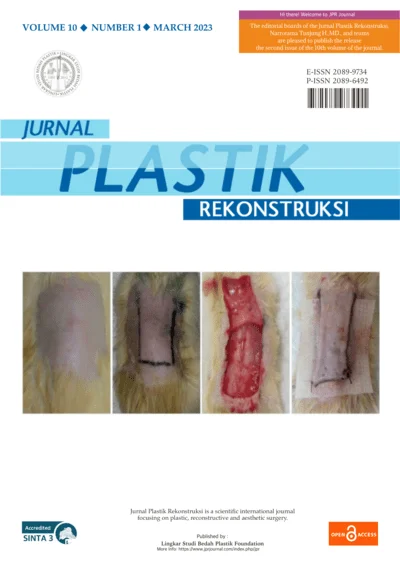Submission Preparation Checklist
- The submission has not been previously published, nor is it before another journal for consideration (or an explanation has been provided in Comments to the Editor).
- The submission file is in OpenOffice, Microsoft Word, or RTF document file format.
- Where available, URLs for the references have been provided.
- The text is single-spaced; uses a 12-point font; employs italics, rather than underlining (except with URL addresses); and all illustrations, figures, and tables are placed within the text at the appropriate points, rather than at the end.
- The text adheres to the stylistic and bibliographic requirements outlined in the Author Guidelines.
Reconstructive
Section default policy
Copyright Notice
Authors retain the copyright of the article and grant Jurnal Plastik Rekonstruksi the right of first publication with the work simultaneously licensed under a Creative Commons Attribution License. Articles opting for open access will be immediately available and permanently accessible for everyone to read, download, and share from the time of publication. All open-access articles are published under the terms of the Creative Commons Attribution-Non-commercial-NoDerivatives (CC BY-NC-ND), allowing readers to disseminate and reuse the article and share and reuse the scientific material. It does not permit commercial exploitation or the creation of derivative works without specific permission.
Privacy Statement
The Lingkar Studi Bedah Plastik Foundation, founders of Jurnal Plastik Rekonstruksi (“the Journal”), is dedicated to maintaining your trust and confidence regarding the privacy of personal information we collect from you.
Your Privacy
Protecting your privacy is our top priority. Please read this policy carefully to understand our views and practices regarding your personal information and how we handle it.
Personal Information
The types of personal information we may collect include:
- Contact Information: such as your name and email address.
- Educational and Professional Background: details about your qualifications and career.
- Account Credentials: usernames and passwords.
- User Contributions: comments or feedback you submit.
We will make every effort to ensure that any personal information collected during the registration process is:
- Adequate, relevant, and not excessive.
- Accurate and up-to-date based on the information you provide.
Unless explicitly stated or with your consent, we will not share your personal information with third parties. However, we may disclose your information:
- To comply with legal obligations or law enforcement requests.
- To protect the rights, property, or safety of our website, content, users, or others.
Please note that any identifiable personal information you voluntarily share in publicly accessible areas of the website (e.g., comments sections) may be collected and disclosed by others. We are not responsible for such third-party collection or disclosure.
You retain control over the personal information you provide to us. If you wish to update your information or adjust your communication preferences, please contact us at the details provided below.
Data Security
The Jurnal Plastik Rekonstruksi website is hosted by Open Journal Systems, which employs appropriate administrative and technical measures to protect your personal information from loss, theft, misuse, and unauthorized access, disclosure, alteration, or destruction.
Policy Updates
This Privacy Policy is reviewed periodically. We reserve the right to amend this policy at any time without prior notice. Continued use of the website constitutes acceptance of any changes.
Cookies
Cookies are small files stored on your device by websites. Most web browsers are set to accept cookies by default, but you can manage or disable them through your browser settings.
We use cookies to:
- Collect anonymous statistical data, such as visitor numbers, geographic locations, browser/OS types, and page views.
- Enhance website functionality for users.
- Support third-party advertising or social media services for tracking and retargeting purposes.
By using our website, you consent to the use of these cookies on your device.
Contact Information
If you have questions, comments, or concerns about this privacy policy or how your information is handled, please contact:
Narrotama Tunjung Hariwangsa, MD
Managing Editor
Email: info@jprjournal.com
Address: Lingkar Studi Bedah Plastik Foundation
Jl. Cimandiri No.21, Cikini, Menteng, Jakarta Pusat, 10330, Indonesia
We will endeavor to respond to complaints within 14 days of receipt.
This Privacy Policy was last updated on April 29, 2024.








